Diese Seite ist derzeit leider nur auf Englisch verfügbar.
Parchment Assessment of the Codex Sinaiticus
Gavin Moorhead
May 2009
Introduction
Parchment is the processed skin of animals, very often calves, goats and sheep that has been soaked, de-haired, stretched and scraped thin. It has been widely used as a writing substrate since around the first century AD, when it began to supersede papyrus and it is the material on which scribes wrote the Codex Sinaiticus. However, despite the making process remaining the same for over two millennia, next to nothing is known about the parchment used for the Codex. Parchment is composed of the natural protein collagen and is prone to different kinds of degradation. Depending on the circumstances, internal and external reactions to mechanical, chemical and biological processes will induce degrees of decay over time.
These facts were important considerations in plans for the Codex Sinaiticus Digitisation Project to ensure its safe handling and a responsible conservation programme. In order to deliver these objectives a comprehensive condition assessment of the parchment was carried out so that experts could determine the level of conservation necessary prior to digitisation and to inform those wanting to solve the puzzles of its physical history.
By observing, measuring and recording the features and characteristics of the parchment, conservators compiled a detailed survey which would act as a condition record and serve as an analysis tool to help determine answers to questions about levels of degradation, identification of animal species and manufacturing processes for the parchment. By studying clues the skin yields such as follicle patterns, skeletal marks, scar tissue, opacity and colour variation an expert can tell much about the species of animal and the condition of the skin. Other man-made characteristics like parchment makers’ holes and repairs, striations, uniformity of thinness and veining demonstrate much about the quality of the making process and the skill of workmanship.
The condition assessment also served as a locator and quantifier of the visual evidence so that the information could be used as a guide to target safe handling; a tool for prioritising conservation; a resource for further analysis; an archive record for conservation treatment and a reference for future surveys.
Codex Sinaiticus Parchment Assessment Model and Methodology
The assessment model is a data matrix which contains a list of features to be documented and the methodology of how they will be observed and recorded. The list includes the parchment features that would best inform questions of origin, manufacture, current condition and degree of degradation. The methodology uses non invasive measurements that are standardised and designed to be carried out by individual teams in different locations. When complete this documentation will function as a description of the substrate and represent the most comprehensive, condition record of the parchment features.
The design of the model was the result of a consultative process shaped by three interdependent considerations. The first of these was to determine which features would be recorded and how they could be measured in an objective, consistent way. The second was to ensure the record of measurements would be searchable, quantifiable and comparative so that it could function as a research reference tool for this project and as an archive for any future condition assessments. This was to assist scholars and conservators seeking information to support research into the history of the Codex’s whereabouts; its use; the comparative analysis of its features and the comparison of it with other codices. The third consideration was that the model should address the logistical limitations of safe handling and enable identical assessments to be made across four geographic locations.[1] Here the model needed to employ conservation ethics in the methods of assessment and utilise standardised measurements to ensure accurate assessment of the condition of the parchment no matter where or when it was being used. Transferable accuracy and repeatability in the observations were of immense importance for future assessments that might determine the rate of degradation and for comparative analysis.
With the Codex Sinaiticus spread across four countries, the method for undertaking and recording the assessments required easy communication and be simple to use. It was necessary to maximise the use of universal standards and minimise the use of language specific input. Some of the standardised measurements developed by the Improved Damage Assessment of Parchment network[2] (I.D.A.P.), in which the British Library is a partner, were chosen for their simplicity, and repeatability in any location. Elsewhere, a glossary of information about the assessment model evolved to facilitate ease of use at each of the holding Institutions.
The Documentation Model was designed using the simple linear box grid of a Microsoft© Excel spread sheet, chosen for its familiarity, general availability and its ease of operation. Users could record mostly numeric and single character information into the box grid from over 150 different assessment tasks.
Assessment tasks were grouped into six categories: Parchment; Scribal; Codicology; Previous Treatment; Condition; and Conservation. The Parchment category was further sub-divided into a list of 25 skin features, physical characteristics and dimensions needing to be checked and recorded, requiring the assessor to carry out 13 different observations and measures.
Each assessment task was described in a glossary[3] appended to the spread sheet. These task descriptions combined instruction steps for manual activity with images for visual support. The desire for comparison and standardisation of the condition assessment across all holding sites meant that it was important for any participant to use identical methodology. Thus, the glossary acted as a translatable set of explanations and visual cues about what was being looked for and done. In this way, identical observations and measurements could be made under identical conditions in all locations, optimising the degree of accurate data collection and comprehension.
Visual checks identified hair or flesh sides of the skin and checked for the existence of hair follicles, axilla areas, skeletal marks, scar tissue, veining, parchment maker’s holes, parchment maker’s repairs and striations. The existence of any of these features were to be located using a grid map[4] which divided each folio into four (or for some folios two) text-column and six margin areas, identified using lowercase alphabet letters. This grid area letter(s) was recorded into the spread sheet to indicate where particular evidence occurred. No evidence would be recorded as N.
Physical characteristics were assessed using standardised comparative checks and methodology developed by I.D.A.P.[5] The colour, opacity and appearance of each folio were determined by matching and measuring with reference samples. The assessor recorded the colour code, numeric opacity value and appearance code letter into the spread sheet.
Thickness measurements were made at seven different locations[6] using a calliper micrometer. Each numeric value was recorded then collectively calculated for a mean average and a minimum to maximum variance.
Codex Sinaiticus Parchment Features
History
Parchment is generally considered to be the consequence of a rivalry between Egypt and Pergamum[7] which occurred five centuries before the Codex Sinaiticus was created. It was an innovation born from the need to create a support material for writing in the absence of papyrus during its embargo beyond Alexandria in the 2nd Century BCE. By mid-4th Century ACE when the Codex Sinaiticus is thought to have been written, the manufacture of parchment had already developed for hundreds of years. At this time, parchment was superseding papyrus as the most commonly used primary support and its emerging dominance as a writing substrate became instrumental to the development of written material. The natural strength and durability of parchment offered alternatives to traditional writing formats and methods of collating. The ideas of writing on smaller, more manageable folios and sewing them together in what became known as a codex were important factors marking the transition from the rolls and scrolls of classical Greece and Rome, and the decline of this format after four millennia of dominance since Ancient Egypt. The ascendancy of parchment and the emergence of the codex were mutually dependant developments in the history of writing and the Codex Sinaiticus represents one of the earliest parchment codices.
Manufacture
The earliest mention of a leather writing surface is found in an Egyptian text from the Fourth Dynasty (c. 2550 BCE)[8] and Herodotus describes writing on skins as common in the 5th century BCE.[9] But the tanning process used to make leather created difficulties producing a thin, smooth sheet, free of wrinkles. It is possible that the impetus of the papyrus embargo led to refinements and experimentation in the way animal skins were traditionally processed, but there is no record of how and when the tanning procedure came to be excluded and replaced by the liming process from which parchment developed.
Despite more than four centuries of production since its emergence till the time when it was created for Codex Sinaiticus, the basic methods of parchment production remained unchanged. Even to this day, it is still a process of making an animal skin thin and flexible by soaking it in lime baths to remove the hair, then washing, stretching and scraping the upper skin layers away, before final drying and thinning.
Skin Selection
Quality parchment relies on the selection of good skins unblemished by flaws. Animals can suffer from skin diseases or parasites such as ticks which have the potential to scar and discolour the skin of the flayed animal. The colour and quality of the wool or hair will also be reflected on the final surface of the parchment. White sheep or calves and goats will tend to produce white parchment, whereas animals with darker coats will produce parchment showing shadowy brown patterns. Other important factors that influence the subsequent quality of the parchment are the age and health of the animal at the time of slaughter and whether the animal has been injured, tethered or used for work. Young and healthy animals generally yield finer, suppler parchment, while things like tethers and work yokes can toughen skin around necks and shoulders, leaving undesirable visual qualities. One final consideration that can prompt selection is the fact that skins can discolour from residues in the blood vessels. After slaughter, carcasses would need to be hung thoroughly so as to all the blood drain out and minimise the potential for discolouration.
Washing and Lime Bathing
After being flayed the skins would most probably be preserved temporarily in salt. Once selected, the skins would have been washed in water over a number of days to clean off dirt and preserving salt. They would then be immersed in a bath containing a liquor of water, hydrated lime or calcium hydroxide and other additives which would aid fermentation. Reed mentions many different additives, including salt and flour, wine, urine and even excrement.[10] The bath would have been stirred occasionally and the skins turned periodically over a few days until the bath acted to open the skin fibre structure of the epidermis and dermis and loosen the subcutaneous layer.[11] This in turn lets the hair follicle expand and loosens the hair shaft without damaging the collagen. (See skin anatomy diagram)
Hair Removal
Once loosened, the hair is easily removed. Before the age of machines, skins would have been draped hair side out over a curved surface such as a log and the parchment-maker would scrape away the hair and outer skin film using a long curved knife with a handle at each end, taking care not to damage the skin below. After the hair was removed the skin would be washed again over a number of days to remove the lime and other residues before being prepared for stretching on a wooden frame called a herse.
Stretching and Scraping
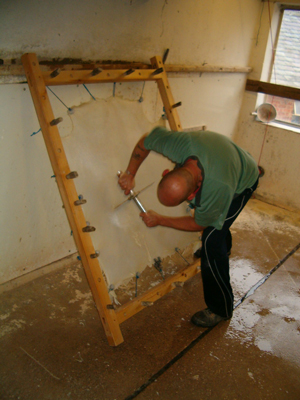 |
| Stretching and scraping (Photo courtesy of Cowleys) |
The wet skin is strung at many points around the edges to tension pegs in the herse. As the skin starts to dry, adjustments are made to the tension to obtain uniform contraction and avoid tearing. While still wet the skin is scraped with a semi-circular knife called a lunellum to remove further layers of the upper dermis and it is the ability of the parchment maker to judge the tension combined with their skill with the scraping tool that determines the quality and uniformity of the finished product. Properly strung and tensioned, the whole skin resembles and feels like a trampoline membrane but consequentially, any tiny gashes or cuts made in the flaying or de-hairing stage will be pulled out into circular or oval holes. Sometimes the holes remain and will be present in the pages or margins of parchment manuscripts. However, the parchment maker can choose to stitch the holes up with thread and in these cases they appear as stitched slits or, if the repair fails under tension, as holes with stitch prickings around them. Eventually the skin is allowed to dry completely while still on the frame, becoming tight as a drum as it does so. Then the scraping resumes in a more measured and exacting way until the desired thickness is reached.
Thinness and Finishing
Despite the manufacturing principles remaining unchanged throughout the history of parchment making, the end product has varied greatly. This variance can be a consequence of things like the maker’s expertise, the quality of the skins and different raw materials used in the production processes. It could also be argued that the wealth or economy of the making process will be reflected in the degree of thinness and finish. The parchment used for the Codex Sinaiticus is incredibly uniform and thin. In the absence of contemporary parchment Codices, comparative analysis cannot help explain the quality of the parchment but it is indicative of lavishness, quality materials and expert workmanship. Whether the removal of material has been achieved mechanically, chemically or in combination, the parchment has been reduced to a paper-like thinness. Most material would be removed from the flesh side but the grain or hair side of the skin would also have its glassy top layer or so called ‘silver membrane’ completely removed along with any remaining follicles. Finally the surface would be rubbed smooth with pumice stone to give a polished and in some cases a whiter appearance. Although it can appear thin and delicate, parchment is in fact extraordinarily durable. If it is made well and kept safe from moisture, temperature fluctuations and excessive light levels, it can, as in the case of Codex Sinaiticus[12], last for at least a thousand years or more in very good condition.
Degradation
Although skin materials are remarkably durable given reasonable conditions of storage, collagen fibres nevertheless degenerate slowly especially when exposed to water vapour, light and heat.[13] Fluctuations in humidity and excessive moisture levels can result in hydrolysis[14] which, in the presence of natural and man-made pollutants such as sulphur dioxide or nitrogen dioxide in the atmosphere, can catalyse oxidisation. This process of deterioration leads initially to a reduction in strength of the dermal fibre network causing phenomena such as curling and shrinkage. Over a prolonged period it can lead to a complete breakdown of the fibre structure and more permanent damage such as brittleness, splits and losses. Fluctuating conditions of heat and moisture can also make the parchment fibres vulnerable to a breakdown called gelatinisation. Here, collagen in the parchment is denatured by interaction with moisture, which acts to break the triple helix bonds of the fibres and leave them with a gelatinous structure.[15] Further deterioration can be caused by the reaction of ink ingredients with radical ions in the atmosphere. The destructive mechanism of inks is their ability to create chemical reactions with the carrier or the medium. Scribes often used iron gall ink which is primarily made from tannin (most often extracted from plant galls), vitriol (iron sulphate), gum, and water.[16] This reaction, which is a similar process to rusting iron, is an oxidisation of the metal compounds in the ink. It will cause parchment to suffer an extensive decline in its natural properties where over time, it will eventually becoming brittle and friable.[17] The reactions between the inks and the carrier materials are strongly influenced by environmental and storage conditions, especially temperature and humidity.[18]
Preliminary Examination
The conservation team discovered that, despite being over 1600 years old, the pages of Codex Sinaiticus held at the British Library consisted of a supple, high quality parchment in relatively good condition. This is difficult to put into context as the only other similar surviving 4th/5th Century parchment codices, Codex Alexandrinus[19] and Codex Vaticanus[20] are at this stage unable to be physically compared with Codex Sinaiticus. Certainly the Codex Alexandrinus is also affected by ink corrosion but all have had different histories and conditions affecting their parchment folios and ultimately the data collected by this condition assessment will enable comparisons to be made in future.
Apart from a small percentage of folios with heavy ink corrosion, most of the folios appeared to have survived the rigours of 16 centuries with an unexpected lack of damage, suffering in the main only from small tears and losses along the head, tail, fore-edge and spine folds. Much of this damage is more likely attributable to mechanical damage than physical deterioration. Clues to explain the relatively small amount of ink corrosion and brittleness may be found in the ink recipe. But equally, explanations for the minimal damage and good condition may lie in the secrets of the parchment makers. The current condition of the parchment may also be due to the environmental conditions the codex has experienced throughout its existence.
Appearance and Layout
The physical appearance of the parchment folios tells much about the artefact and the method of its manufacture. That the parchment is extremely fine with relatively few extant imperfections and markings, suggests that the scribes were very selective about the parchment supplied for the manuscript. The low incidence of follicle, axilla and scarring evidence suggests that aesthetics were certainly a consideration. However, this degree of selectiveness for the entire quantity of quality skins would have made the production process a costly enterprise. The prose books are written four columns per page, 48 lines per column, so an opening displays eight columns. The visual effect of the layout is lavish, with regular columns set within generous margins and is reminiscent of a partially open scroll. The poetical books are written two columns per page. The method of pricking and ruling[21] set the model for later Greek and Latin manuscripts that followed in the next 1000 years. That the margin areas are generous at a time when parchment was expensive to produce lends further weight to the idea that there was a wealthy resource behind the production. This idea could also help answer questions asked by Biblical historians who have suggested that the Codex Sinaiticus may have been one of the 50 copies of Christian scripture commissioned by the Emperor Constantine the Great.[22] Certainly the high cost associated with the lavish size, quality of production and skilled craftsmanship could be explained and understood. It could also help explain the resilience and longevity of the parchment over the centuries, in that the obvious quality of the parchment seems to reflect the precious nature of the object and subsequently, the way this codex may have been cared over time.
Quantity
The manuscript is made up from gatherings of parchment sheets called quires. These quires consist of 4 bi-folios[23] or 8 leaves and in its original state the Codex probably contained at least 730 leaves or 365 bi-folia. Quires would be arranged with the flesh side of the parchment outermost then alternating with the matching sides facing each other throughout the quire. The current folio dimensions of the bifolium are roughly 380mm (height) x 680mm (width) but from the evidence of trimming[24] the original open bi-folium could have been at least circa 400 x 700 mm (16 x 28in). Lack of skeletal evidence suggests that the folios were cut from the flanks of large skins which would need to have been about eight square feet in area. (See figs. 1 & 2. below) Even with stretching on a herse, the size of the bi-folios would suggest that the parchment is not uterine[25] and would contest the idea that the fineness and thinness of the parchment is a result of this. If two bi-folia could be cut from either side of a sheep or calf skin, calculations suggest that almost 200 near perfect skins would be required for this manuscript, displaying a humbling level of manufacturing skill so early in the use of parchment.
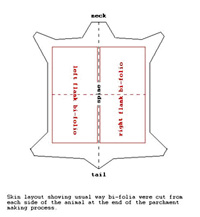 |
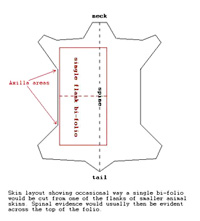 |
| fig. 1 |
fig. 2 |
Natural Skin Features
Despite the twentieth-century binding tending to hide its codicological history the original nature of the parchment is still evident. Natural features such as hair follicles, axilla, veining, skeletal marks and scarring reveal much about the animal of origin, its quality of life and the way the skin was processed.
Follicles
Follicle evidence varies from faint marks to well defined hair sacs still containing hair stubble. The patterns of these hair holes, if well defined, allow experts to determine the type of animal the parchment was made from. However this can be made difficult when skin fibres gelatinise in the hair holes and when the hair holes get distorted by the stretching process of manufacture. The question of animal origin has been of interest after claims by Tischendorf[26] that, the skins used to produce the parchment for the Frederick Augustus Codex (Leipzig folios) and the Codex Siniaticus was that of antelope. Unfortunately, much of the remaining follicle evidence has been gelatinised and distorted making it difficult to determine animal origin with the naked eye. However microscopic analysis by René Larsen[27] has determined two types of animal origin; calf and wool sheep (see figs.3 and 4). He examined 28 folios with significant follicle evidence and was able to positively identify 15 as calf; 4 as most likely calf; 2 as wool sheep and the remaining 7 as unidentifiable. Although an untrained eye may not see much difference, the calf follicles appear in rows or short lines of 3 or 4 follicles whereas those of the wool sheep are grouped into clusters.
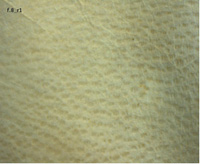 |
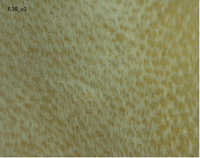 |
| fig. 3: Calf follicle pattern (Q38 f.2r, BL f.8r) |
fig. 4: Sheep follicle pattern (Q41 f.1v, BL f.30v) |
Skeletal marks
Skeletal evidence can be detected in parchment because the skin that stretches over these bone structures is of a different density to the surrounding skin. When lit from behind, the parchment can appear to show the outlines of distinctive bones such as vertebrae with characteristic light and dark shapes evocative of an ‘x-ray’ style. (see fig.5:) For the most part, definitive skeletal evidence was scarce. This led to the conclusion that, with the exception of a few folios, each parchment bi-folio was cut from a flank of the animal skin well away from the spine, neck and pelvic regions. When evidence suggestive of skeletal features is present in the folios, it was concluded that perhaps the skin came from a smaller animal or as in the case of fig.5: that perhaps the folio could have included some of each flank with the spine somewhat central.
Axilla
The axilla areas are characterised by looser skin often found around the belly, groin and under shoulder regions (see fig. 6). The follicle patterns are generally more spread and the surface of the skin is more stretched and undulating. When considering these areas in conjunction with skeletal evidence, the observer can map the parchment onto the animal and so determine where the parchment was cut from the skin. This in turn can inform the process of animal identification. Axilla evidence was not abundant and appeared only on the folio edges suggesting, that apart from a few smaller skins, most were large enough to afford the luxury of allowing the bi-folium to be cut well inside undesirable features.
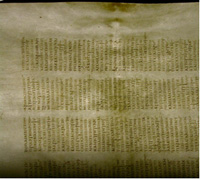 |
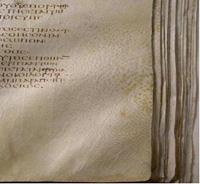 |
| fig. 5: Skeletal Marks (Q41 f.4r, BL f.33r) |
fig. 6: Axilla area (Q67 f.2r, BL f.153r) |
Veining
This refers to visual evidence of the vessels through which blood flowed in the skin layer (see fig. 7). At the time of slaughter, even though the skin has ceased to be living tissue, blood will remain in the vessels unless it is drained out. Proper drainage of the blood vessels is essential, otherwise the iron compounds of the blood will react with the lime liquors to form dark coloured pigments which are extremely difficult, if not impossible, to remove.[28] Well drained animal skin can make veining evidence almost invisible and often only detectable as translucent areas when back lit. None of the veining evidence recorded in the assessment showed discolouration and is consistent with the idea that the quality of the parchment is high.
Scarring
This assessment category records evidence of various circumstances that often result in a visible change to the surface of the skin (see fig. 8). Collectively referred to as scar tissue, these features usually occur in the aftermath of injury, infestation or abnormal skin condition. The most common scar is where an injury or wound has caused the skin to break and the repair process is made without the body being able to re-create healthy skin or tissue. In its place the body puts together new connective tissue fibres that are not as functional as the original skin and which serve as a protective barrier until healing is complete.
Pest infestation from things like ticks and lice can also appear as scar-like features in the skin, where the tissue gets infected by the insect or from animal activity such as biting and scratching at the problem. Poor health of an animal can often lead to skin conditions which, if severe enough can be manifest in the appearance of the parchment, but it is hard to attribute such features with visual evidence alone. The idea that the skins used to make the parchment for Codex Sinaiticus were of fine quality is further supported when consideration is given to the scar evidence. Most of the scarring is small in size and tends to occur in the margins near the edges. This could suggest that only quality skins were chosen for this enterprise and that any skins showing significant scarring could afford to be discarded. It could also suggest that the animal husbandry that produced the skins was meticulous and well resourced. It could be argued the lack of significant scarring resulted from these animals being well fed and tended, perhaps even bred specifically for the task.
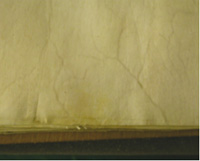 |
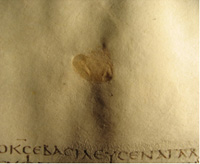 |
| fig. 7: Veining |
fig. 8: Scar tissue |
Manufacturing Features
It is not only natural features that can be obvious on parchment. Evidence reflecting the degree of skill and workmanship in the parchment manufacturing process can also be found in the finished product. When the skin is removed from the animal and the hair is removed from the skin, any careless or unskilled knife work can leave nicks and cuts with the potential to become holes or tears during the stretching and scraping processes.
Another important part of the making process having direct influence on the physical features is the simultaneous changes in the skin caused by the actions of stretching and drying. Here the dermal fibre network changes from a 3 dimensional interlocking network into aligned layers parallel to the surface of the skin, making it easier to scrape thin and giving the parchment surface its appearance and hard, glue-like consistency. Thus, the look of the parchment can depend on the extent of the alteration of fibre orientation which in turn depends on several factors, including the species, age and diet of the animal from which the skin came; the intensity of the liming it has received; and the tension and rate at which the wet, stretched skin is dried.[29]
Maker’s Holes
The ideal skin would be unmarked but a skilled parchment maker will recognise vulnerable areas of marked skins and usually be able to work with the problem to minimise the affects. However, a mistake in tensioning the skin on the stretching herse and in using the lunellum to scrape the skin, can cause the nicks and cuts to open into holes or become much larger tears. These are referred to as parchment maker’s holes and can be large (over 25mm in diameter) or small. The size of the hole often suggests the ability of the maker to deal with the skin defects but sometimes the makers may sew up holes to prevent them becoming larger problems during the latter stages. When they have been sewn up, they are referred to as parchment maker’s repairs and they often resemble stitches that a doctor closes a wound with.
Holes that are present at the time of stretching tend to be larger and receive less scraping attention lest they be made worse. As a consequence, areas around the hole tend to be thicker and retain some of the fatty layers normally scraped off. (see fig. 9). Holes can also occur during scraping when too much material is removed. These holes tend to be smaller and characterised by membrane thin edges which could be likened to an eraser wearing through paper (see fig. 10). Other holes can be made intentionally to identify the parchment maker and these would be noticeable by repetition. No such marks were found despite some debate in one instance (see fig. 11).
The number of folios in the Codex Sinaiticus with maker’s holes is small and when evident, the holes tend to be located in the margins, well away from the text. The majority of the holes themselves are small (<5mm in diameter), suggesting expertise in manufacture and/or a high level of quality control by the scribes. Both would have been expensive requisites, lending further weight to the wealth of the enterprise. There is no obvious evidence of a makers repair apart from a part-obscured hole in the spine margin of BL OT f.16 which appears to have puncture marks around it, perhaps from a repair no longer in-situ.
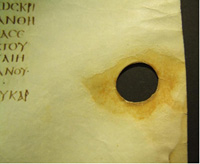 |
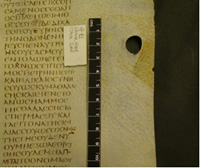 |
| fig. 9: Maker’s hole (untouched) in BL f.55r |
fig. 10: Maker’s hole (scraped) in BL f.61r |
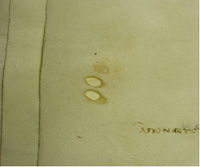 |
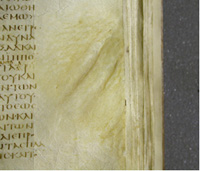 |
| fig. 11: Maker's holes in BL f.197v |
fig. 12: Striation in BL f.8r |
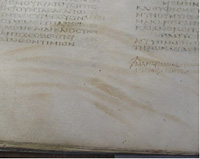 |
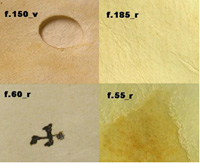 |
| fig. 13: Striation in BL f.131v |
fig. 14: Colour variance |
Striation
When the parchment maker scrapes the skin he uses a curved, two handled blade called a lunellum which is kept at a near perpendicular angle to the plane of the skin surface. In skilled hands, this blade is capable of reducing the thinness of the parchment to fractions of millimetres but if the optimum blade angle is not maintained, the curved edge can skitter and jump leaving characteristic marks of more open fibre structure called striations. Looked at under magnification and with raking light, striations resemble waves with a crest and trough but to the naked eye they appear as areas having alternating lines of highlight and slight shade. (see figs. 12 & 14)
Evidence of striation on the folios of the codex is not abundant but there are some examples which are uncharacteristic of the usual high quality (see fig.11). Like the other undesirable features, striation tends to occur in the margins away from text areas. From a practical point of view, this could be due to the more open surface fibres found in a striation being inclined to soak up ink and therefore only acceptable where they would not be written on. From an aesthetic point of view they are visually unsightly, so the standard of selection may have excluded all but a few folios and been excepting of those where the striation location did not compromise the look of the folio.
Thinness
Thinness and consistency of thinness is the ultimate goal of the parchment maker and can only be achieved with quality materials and skill in processing them. Being a hand-made product, individual ability and experience also plays a major part in the fineness of ‘paper-like’ parchment. A quality maker will have enough experience to be instinctive about skin selection, correct tensioning and the amount of material to be scraped off that will deliver a thin, consistent product. The desire for a more uniform thinness has led to refinements in the preparation processes. Particularly in the case of sheep skins, makers have developed a method of mechanically splitting the skin laterally into two thinner layers where the grain, or wool, side of the skin is made into skiver[30] and the flesh, or lining side of the skin, is converted into parchment.
In the case of Codex Sinaiticus, the quality of the parchment is fine and the folios have an amazing uniformity of thinness ranging between 0.1 and 0.2 mm. In the absence of comparative codices it is hard to say whether this is exceptional but if one considers the skill level required it is no less than remarkable. Had the animal origin been solely wool sheep, the thinness might have easily been attributed to skin splitting. However, the predominance of calf skin seems to rule this out unless the ancient parchment makers had perfected a method of splitting calf skin. Reed suggests that large, strong sheets could be produced from the grain splits of cattle hides that give a more even character over greater areas, but his comments are based on modern methods.[31] Reed also describes a number of different parchment maker’s recipes[32] so it is not unreasonable to think ancient parchment makers used ingredients in the lime baths or on the skins during the making process which helped to achieve the thinness. Special baths may have treated the skin in a way that enabled it to be scraped in a far more controlled manner or perhaps the skin was coated with an acid-like paste which removed layers of skin and fat, not unlike modern-day exfoliation. Until further analysis can determine some answers, these suggestions remain speculative.
What can be said with certainty is that any 4th Century parchment with this amount of flexibility, thinness, maker’s holes, repairs and striation is exceptional. It remains indeterminate how these features came to be or how the making process and rigors of history have impacted on the longevity of the parchment.
Degradation Features
Some of the physical parchment features are attributable to the process of degradation. Colour, opacity and surface appearance change in relation the progress of natural decline and the environments skin products exist in. The chemical breakdown of the fibre structure can be catalysed by residues from the making process or from airborne pollutants and be accelerated by excessive moisture or heat. Photochemical degradation from excessive UV radiation in daylight can also break down and gelatinize the parchment. Signs of degradation such as discolouration, gelatinization and brittleness can be measured to determine the condition of the parchment and rate of decline. This helps conservators determine strategies for treatment and storage. The condition assessment of Codex Sinaiticus incorporated the I.D.A.P. network[33] non-destructive methods for damage assessment where conservators colour-matched the parchment, measured its opacity and determined the surface appearance. Overall, the condition of the parchment is exceptional for its age. Much of the visual degradation has occurred where the ink has interacted with the surface of the parchment. This is referred to as ink corrosion and is discussed further within the ink analysis. Briefly, the degradation has occurred in a reaction with ingredients in the ink recipe and the collagen fibres.
Colour
The colour of parchment varies with animal type, making process and condition or state of decline. New parchment can be near white but as it ages or is exposed to detrimental factors it will start to yellow and go brown-black if left to degrade completely. The colour change can also be influenced by the type of degradation and degree of gelatinization (see fig. 14).
Colour was determined under controlled lighting using a selection of 24 different colours from the Natural Colour System (NCS) Colour Atlas 96.[34] and recorded by the NSC code. Only a few folios in the codex could be considered to be heavily discoloured and these tended to be the folios that were once adjacent to missing parts and therefore, more exposed.
Opacity
The ability of light to pass through parchment will diminish with age and degree of degradation. A light meter was used to measure the amount of light passing through the folios of the codex. The opacity is the amount of light passing through the parchment divided by the amount of light passing through the standard sample. Opacity values for the codex did not vary significantly and tended to reflect thickness variances rather than increased degradation.
Surface Appearance
This will vary according to age, condition and use. New parchment has a neutral lustre which can turn matt or highly glossy depending on the type and length of degradation. Highly gelatinized parchment can even start to turn transparent.
Conservators compared the folios in the codex with standard I.D.A.P. samples.
These three types of measure would also be repeatable under the control conditions in any future assessment. In this way, any significant changes in colour, opacity and appearance, could be accurately identified and help determine the rate – if any – of degradation.
Conclusions
Much of the visual parchment evidence cannot answer many of the questions asked by those seeking proof about the origins of the Codex and the story of its survival. It does however prove the animals of origin question and remains indicative of the fineness in the parchment their skins produced and the finesse of the workers that created it.
The parchment is:
- Both bovine (calf) and ovine (wool sheep) in origin.
- Exceptionally uniform in thinness.
- Supple and flexible in quality.
- Generous in bi-folio size and lavish in layout.
- Characterised by a sparse quantity of visual imperfections and blemishes.
The parchment features reflect:
- A well resourced enterprise.
- The idea of excellence in the animal husbandry.
- High standards in the selection of skins.
- High degree of manufacturing finesse.
The parchment condition is:
- Exceptional for its age.
- Low in levels of significant degradation.
- Affected by long-term ink corrosion.
- Affected by gelatinisation.
It is the intention of the conservators to continue the analysis of the parchment features. It is hoped that with the availability of all the documentation data, it can then be used to compare the differences in folios across all holding sites and to help draw some further conclusions. There has already been some work done on stain mapping consecutive folios that are in different locations and these will also be compared for differences in colour and dimension in the hope that any disparity can answer some of the questions that still remain.
References
[1] British Library, London; Leipzig University Library, Leipzig; National Library of Russia, St. Petersburg; St Catherines Monastery, Mt Sinai, Egypt.
[2] See IDAP Appendix in Glossary Notes or I.D.A.P. website http://www.idap-parchment.dk/portal/DesktopDefault.aspx.
[3] Parts of this glossary can be seen by expanding the information prompt boxes within the Physical Description section for each folio of the Codex on the website.
[4] See ‘Grid’ in Glossary Notes.
[5] See IDAP Appendix in Glossary Notes or I.D.A.P. website http://www.idap-parchment.dk/portal/DesktopDefault.aspx.
[6] See ‘Grid’ in Glossary Notes for locations.
[7] Tradition has it that parchment was invented as the result of rivalry between King Ptolemy V of Egypt and King Eumenes II of Pergamum about 190 BCE. Fearing the library at Pergamum might outstrip the collections at Alexandria, Ptolemy placed an embargo on papyrus to prevent his rival from making any more books, whereupon Eumenes made parchment. Both the Greek and Latin words for parchment mean “stuff from Pergamum”. From: History of Publishing. http://www.britannica.com/EBchecked/topic/482597/publishing/28607/Vellum-and-parchment.
[8] From: Writing (Scripts, Materials and Inscriptions). http://www.jewishvirtuallibrary.org/jsource/judaica/ejud_0002_0021_0_21120.html
[9] From: Parchment History. http://en.wikipedia.org/wiki/Parchment.
[10] Reed, Ancient Skins, Parchments and Leathers, pp.46-55.
[11] Overview of Leather http://www.kb.nl/cons/leather/chapter.
[12] Based on paleographical analysis, Codex Sinaiticus is generally dated from the mid-fourth century making it over 1600 years old.
[13] Reed, Ancient Skins, Parchments and Leathers, p.313.
[14] Hydrolysis literally means reaction with water. It is a chemical reaction during which one or more water molecules are split into hydrogen and hydroxide ions which may go on to participate in further reactions.
[15] Hansen, Lee & & Sobel, "The effects of relative humidity on some physical properties of modern vellum", Journal of the American Institute for Conservation 31:3 (1992), Article 5 (pp. 325 to 342).
[16] The Ink Corrosion website http://www.knaw.nl/ecpa/ink/ink.html.
[17] The Ink Corrosion website http://www.knaw.nl/ecpa/ink/ink.html.
[18] The Ink Corrosion website http://www.knaw.nl/ecpa/ink/ink.html.
[19] British Library, MS Royal 1. D. V-VIII.
[20] The Vatican, Bibl. Vat., Vat. gr. 1209.
[21] Scribes would puncture a folio with a pointed tool to mark the position of column boundaries and line spacing. They would then score a series of ruled vertical and horizontal lines to act as guides for the text.
[22] In 322 CE, Constantine, the first Christian Emperor, ordered fifty Bibles from Eusebius Pamphilus, Bishop of Caesarea, for the new churches in Constantinople.
[23] A bi-folio is one sheet folded in half to create 4 pages con-joint with a spine fold.
[24] See folio 4 from Q69_CS OT BL f.171.
[25] Uterine parchment is produced from the skin of an animal foetus. The skin of an unborn animal develops early and has a well-formed dermal fibre network which is both thin and strong. This makes it ideally suited for producing strong parchment with remarkable thinness. See R. Reed, Ancient Skins, Parchments and Leathers, 1972, p.126.
[26] Constantine Tischendorf, the Biblical Scholar who rediscovered the Codex and who produced a facsimile version of it made a claim about the animal origin. Roughly translated from Latin it reads: ‘When seeking those animals whose skins might be most suitable for making parchment, it can hardly be doubted that before all others, the species of antelope which is even now most common in the deserts of Libya, Egypt and Arabia supplied the parchment from which the Frederick-Augustus Codex was made’. See C. Tischendorf, Codex Friderico-Augustanus sive fragmenta Veteris Testamenti e codice Graeco omnium qui in Europa supersunt facile antiquissimo in Oriente detexit in patriam attulit ad modum codicis edidit Constantinus Tischendorf, Leipzig, 1846.
The same claim has been made in: C. Tischendorf, Bibliorum codex Sinaiticus Petropolitanus: Ex tenebris protraxit in Europam transtulit ad juvandas atque illustrandas sacras litteras edidit C. Tischendorf, 4 vols., St Petersburg, 1862. (introduction) to : Vol. 1 on f.6* of the Prolegomena.
[27] René Larsen from The School of Conservation at The Royal Danish Academy of Fine Arts in Copenhagen.
[28] Don Etherington, Bookbinding and the conservation of books; A dictionary of descriptive terminology.
[29] Don Etherington, Bookbinding and the conservation of books: A dictionary of descriptive terminology.
[30] Skiver is the outer layer of split sheepskin that is tanned and made into thin, soft leather and which is often used for decorative gold tooling.
[31] Reed, Ancient Skins, Parchments and Leathers, p.126.
[32] Reed, Ancient Skins, Parchments and Leathers, p.132-135.
[33] http://www.idap-parchment.dk/portal/DesktopDefault.aspx.
[34] Natural Colour System, Swedish Standard SS019102 Edition 3.